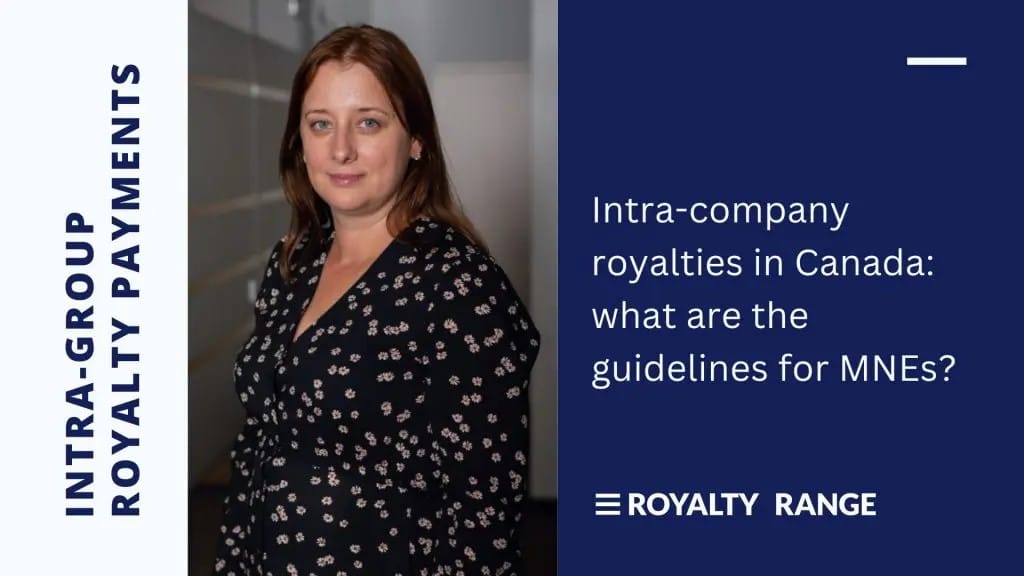Intra-group royalties in Canada: what are the guidelines

Asta Rudzikiene |
November 15, 2023

Intra-company royalties in Canada: what are the guidelines for MNEs?
Transfer pricing professionals serve as the navigators of a complex and dynamic landscape, ensuring multinational enterprises (MNEs) comply with intricate regulatory frameworks. One of the central challenges we face is the management of intra-company royalty payments, a task that requires an understanding of the regional guidelines established by countries around the world for transfer pricing and setting fair rates for transactions that aren’t directly subject to external market forces. In Canada, with its rigorous tax regulations, these guidelines are particularly stringent and require specialised expertise to navigate.
This article is a guide for transfer pricing professionals seeking to work with Canadian guidelines governing intra-company royalty payments. Our focus is to give you the in-depth knowledge and insights necessary to ensure that your MNE clients remain fully compliant with Canadian tax regulations.
Throughout this guide, we will look at the core principles and essential regulatory considerations. It is designed to equip you with the knowledge and strategies required to excel in your role as a compliance expert in this complex field.
What are royalty rates?
Royalty rates are fees paid by one party (the licensee) to another party (the licensor) for the authorised use of intangible assets or intellectual property (IP). For MNEs, this means the payments set under licensing agreements between intra-group entities.
These assets can encompass a wide range of items, such as patents, trademarks, copyrights, and proprietary technologies. Royalty rates are typically expressed as a percentage of revenue, sales, or a fixed monetary value, and are formalised through licensing agreements that outline the terms and conditions under which the intellectual property can be utilised.
Overview of the guidelines and taxation of intra-company royalty rates in Canada
Intra-company royalty rates in Canada are subject to specific guidelines and taxation regulations. Understanding this framework is crucial for MNEs to manage their intellectual property efficiently and ensure they set royalty rates correctly.
Canada transfer pricing regulations: Canada adheres to transfer pricing regulations that require intra-company transactions, including royalty payments, to be conducted at arm’s length. These regulations are primarily governed by the Canada Revenue Agency (CRA). The arm’s length principle ensures that transactions between related entities should be priced as if they were between unrelated parties.
OECD guidelines: Canada aligns its transfer pricing regulations with the guidelines set forth by the Organisation for Economic Co-operation and Development (OECD). The OECD’s guidance provides a global standard for transfer pricing, including royalty rates, to maintain consistency and minimise double taxation issues.
BEPS actions: Canada has also implemented Base Erosion and Profit Shifting (BEPS) actions recommended by the OECD. These actions include enhanced documentation requirements and guidelines to prevent the tax base from being eroded by companies shifting profits to low-tax jurisdictions.
Royalty taxation in Canada
Royalties paid to non-resident licensors by Canadian entities are generally subject to withholding tax. The withholding tax rate can vary depending on the tax treaty agreements between Canada and the licensor’s home country. The standard withholding tax rate under the Income Tax Act is 25%, but under certain tax treaties a lower rate may be applicable.
The taxation of royalties in Canada is influenced by various factors, including:
Tax treaties: Canada has tax treaties with numerous countries that often reduce the withholding tax rate on royalties. MNEs should refer to the specific tax treaty applicable in their case to determine the exact withholding tax rate.
Arm’s length principle: As per the arm’s length principle, royalty rates in Canada should be set at rates that would be agreed upon by unrelated entities. Documentation demonstrating the reasonableness of the royalty rates is essential.
Compliance and reporting: MNEs must ensure compliance with Canadian transfer pricing regulations. Proper documentation of intra-company royalty agreements is vital, and it’s necessary to file appropriate transfer pricing documentation with the CRA.
In summary, understanding and complying with the guidelines and taxation of intra-company royalty rates in Canada is crucial for MNEs to effectively manage their intellectual property and maintain compliance with Canadian tax regulations, transfer pricing principles, and international agreements.
Royalty rates in Canada: frequently asked questions
Are there specific guidelines for setting royalty rates in Canada?
Yes, Canada has specific guidelines for setting royalty rates, primarily governed by the Canada Revenue Agency (CRA). These guidelines are designed to ensure that royalty rates are set at arm’s length, meaning they should be comparable to what unrelated parties would agree upon in similar transactions.
How are royalties taxed in Canada?
Royalties paid to non-resident licensors by Canadian entities are subject to withholding tax. The withholding tax rate can vary depending on the tax treaty agreements between Canada and the licensor’s home country. The standard withholding tax rate under the Income Tax Act is 25%, but tax treaties should be referred to, as a lower rate may apply.
Is there a difference in royalty taxation at the federal and provincial levels in Canada?
While federal guidelines and withholding tax rates apply consistently across Canada, some provinces may have their own corporate tax rates. These provincial tax rates can affect the overall tax liability of a company but do not directly impact royalty withholding taxes.
What is the significance of the arm’s length principle in Canadian royalty transactions?
The arm’s length principle is a cornerstone of Canadian transfer pricing regulations. It ensures that royalty rates between related entities are set at levels that would be agreed upon by unrelated parties in similar circumstances. This principle is essential for maintaining fairness and transparency in intra-company transactions.
What documentation is required for compliance with Canadian royalty payment regulations?
MNEs must maintain proper documentation of their intra-company royalty agreements to demonstrate the reasonableness of the royalty rates. It’s also essential to file appropriate transfer pricing documentation with the CRA to ensure compliance.
How can companies ensure they are in compliance with Canadian royalty payment regulations?
Ensuring compliance with Canadian royalty payment regulations involves understanding and adhering to the guidelines, conducting arm’s length analyses, maintaining accurate documentation, and seeking expert advice when necessary.
Premium-quality data for accurate royalty rates
The Canadian guidelines for MNEs regarding intra-company royalty payments are a framework designed to ensure equity, transparency, and adherence to international standards. With a commitment to the arm’s length principle and the careful consideration of withholding tax implications, the guidelines provide a robust foundation for MNEs to navigate the intellectual property landscape in Canada.
Kris Rudzika, Managing Partner at RoyaltyRange, writes:
“International guidelines and regulation for intra-company royalty payments are continually evolving, and it’s no different in Canada. The tendency is likely to be towards increased scrutiny and transparency, so MNEs should be prepared to adapt to potential changes, aligning their transfer pricing strategies with the broader international consensus on fairness and compliance, while optimising their intellectual property portfolios for sustainable growth.”
To set royalty rates that are both optimised and compliant, it’s essential to have access to the best data, tools, and guidance.
At RoyaltyRange, our four professional databases – relied on by multinational enterprises, global consulting companies, international law firms and tax authorities in more than 70 countries – cover private company financials and ownership information, royalty rates, loan interest rates and service fees. They provide everything required for transfer pricing, financial transaction benchmarking, royalty rates and service fees benchmarking, valuation of intangibles and purchase price allocations, sales and marketing lead generation and automation, procurement and client onboarding, and KYC/AML procedures.
Find out more about our databases and tools here or read more about transfer pricing in Canada in our article here.
The information provided below is for general informational purposes only and should not be construed as legal or tax advice. It is not a substitute for consulting with a qualified legal or tax professional.




